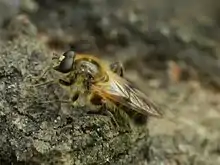Brachypalpus laphriformis
Brachypalpus laphriformis is a species of hoverfly found in Europe.[1]
| Brachypalpus laphriformis | |
|---|---|
 | |
| Brachypalpus laphriformis Olsztyn, Poland | |
| Scientific classification | |
| Kingdom: | Animalia |
| Phylum: | Arthropoda |
| Class: | Insecta |
| Order: | Diptera |
| Family: | Syrphidae |
| Genus: | Brachypalpus |
| Species: | B. laphriformis |
| Binomial name | |
| Brachypalpus laphriformis (Fallén, 1816) | |
| Synonyms | |
| |
Description
External images Brachypalpus are medium-sized (wing length 8.5-10.75 mm.) blackish flies with clouded wings. In Brachypalpus laphriformis the thorax and scutellum are unstriped and aeneous black. The abdominal tergites are shining black with red lateral colour at base of abdomen. Hairs on the body surface are sand brown. Hind trochanters with a posterior process. Hind tibiae slightly curved.[2] [3][4][5] The larva is illustrated by Rotheray (1993).[6]
Mimicry
Superficially resembles a honey bee.
Distribution
Brachypalpus laphriformis is a Palearctic species with a limited distribution in Europe[7] South Fennoscandia to the Pyrenees then Ireland east through central Europe and northern Italy to Yugoslavia and European parts of Russia.[8]
Biology
Occurs in wooded areas (over-mature Fagus and Quercus forest with senile trees and fallen, rotting timber) where it is a bioindicator. The "short-tailed" larvae have been found in the rotten wood of trees, and under the bark. Males have a rapid, zigzag flight over the trunks of fallen tree. They fly with a high-pitched buzz. The female can be found investigating fallen trees. Both sexes visit the flowers of umbellifers, Berberis, Crataegus, Photinia, Prunus and Sorbus.[9][10]
The flight period is from the end May to the end of June.
References
- Stubbs, Alan E. & Falk, Steven J. (1983). British Hoverflies: An Illustrated Identification Guide (2nd (revised) ed.). British Entomological & Natural History Society. p. 271, xvpp. ISBN 0-9502891-3-2.
- Van Veen, M. (2004) Hoverflies of Northwest Europe: identification keys to the Syrphidae. 256pp. KNNV Publishing, Utrecht.
- Van der Goot,V.S. (1981) De zweefvliegen van Noordwest - Europa en Europees Rusland, in het bijzonder van de Benelux. KNNV, Uitgave no.32: 275pp. Amsterdam.
- Bei-Bienko, G.Y. & Steyskal, G.C. (1988) Keys to the Insects of the European Part of the USSR, Volume V: Diptera and Siphonaptera, Part I. Amerind Publishing Co., New Delhi. ISBN 81-205-0080-6.
- Coe, R.L. (1953) Diptera: Syrphidae. Handbks.ident.Br.insects, 10(1): 1-98. R.ent.Soc.London. pdf
- Rotheray G., 1993 Colour Guide to Hoverfly Larvae Diptera, Syrphidae in Britain and Europe Dipterists Forum pdf Archived 2019-04-03 at the Wayback Machine
- Fauna Europaea
- Peck, L.V. (1988) Syrphidae. In: Soos, A. & Papp, L. (eds.) Catalogue of Palaearctic Diptera, 8: 11-230. Akad. Kiado, Budapest.
- de Buck, N. (1990) Bloembezoek en bestuivingsecologie van Zweefvliegen (Diptera, Syrphidae) in het bijzonder voor België. Doc. Trav. IRSNB, no. 60, pp. 1-167.
- Speight, M.C.D. (2011). "Species accounts of European Syrphidae (Diptera)" (PDF). Syrph the Net, the database of European Syrphidae. 65: 285pp.